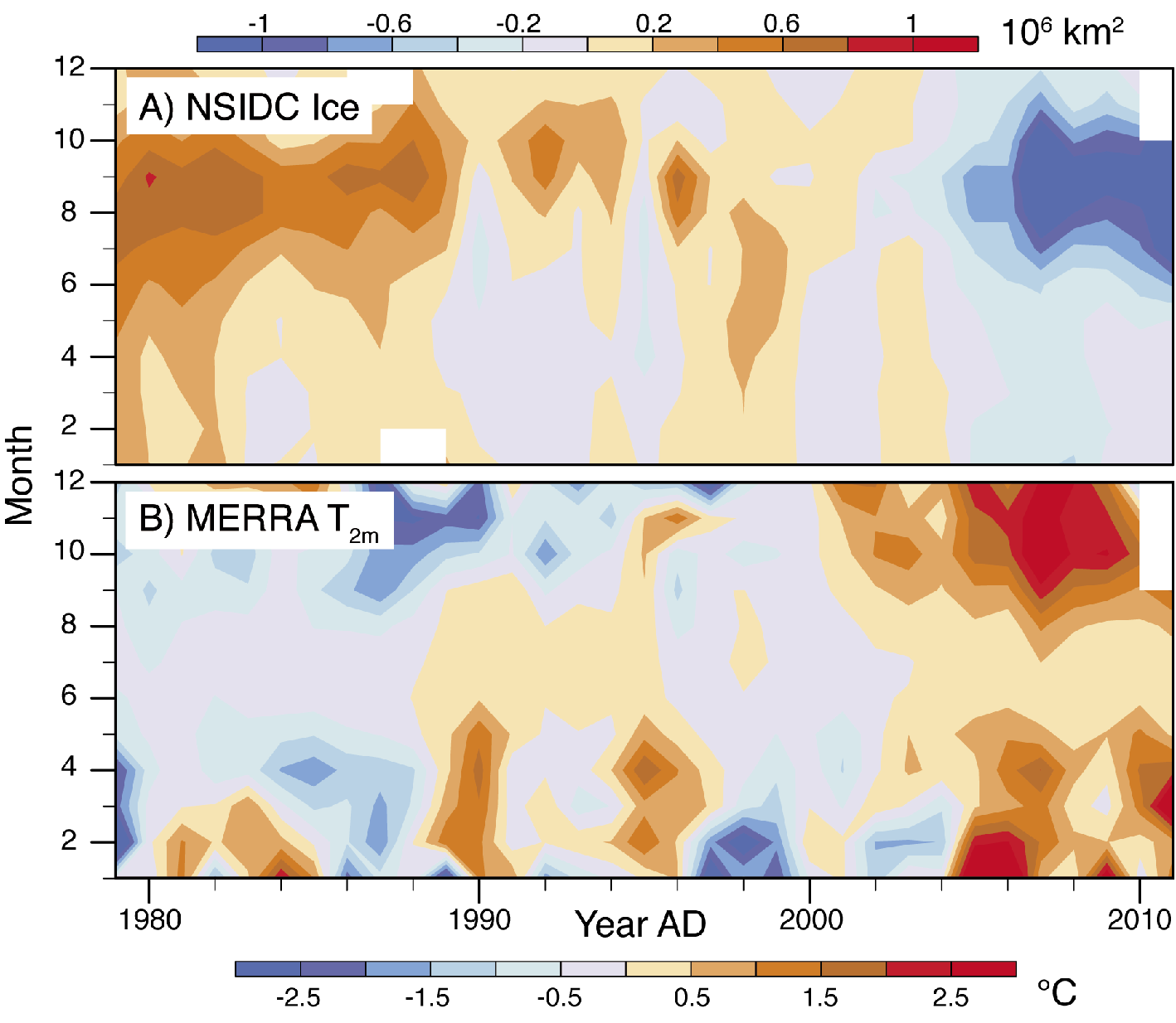- Home
- Publications
- PAGES Magazine
- Arctic Sea Ice - When Will The Arctic Ocean Become Ice-free and What Will Be The Effects? [Present]
Arctic sea ice - When will the Arctic Ocean become ice-free and what will be the effects? [Present]
Mark C. Serreze and Julienne C. Stroeve
PAGES news
20(1)
18
2012
Mark C. Serreze and Julienne C. Stroeve
Cooperative Institute for Research in Environmental Science and Department of Geography, University of Colorado, Boulder, USA; serreze nsidc.org
nsidc.org
It seems inevitable that the Arctic will lose its summer sea ice cover as air temperatures continue to rise in response to increased concentrations of atmospheric greenhouse gases. Over the last 33 years for which we have high quality records from satellite remote sensing, the September (end-of-summer) sea-ice extent has declined at a rate of 13% per decade. The five lowest September extents in the satellite record have all been in the past five years; average extent for this period represents a 35% reduction compared to conditions in the 1980s. Although there will likely be winter sea ice for centuries to come, the ice that forms in winter will be too thin to survive the summer melt season.
Emerging results from the latest generation of coupled global climate models indicate that essentially ice-free conditions (with some residual ice surviving in favored locations) could be realized as early as 2030. However, we may get to an essentially ice free Arctic Ocean, only to see temporary recovery. Modeling work argues for both decadal-scale periods of especially rapid ice loss in the future and periods of increasing ice extent. This implies that concern over a tipping point in ice thickness that, when crossed results in a rapid slide to an ice-free state, is likely unfounded.
Given that environmental impacts of ice loss will be realized well before one gets to a truly ice-free state, the year at which we first see a blue Arctic Ocean is not as important as when the bulk of the ice is gone. Some within-Arctic impacts of sea-ice loss are already here. This includes loss of species habitat, northward migration of marine species, and increased coastal erosion along the Beaufort Sea coasts and elsewhere due to increased wave action and thermal erosion of permafrost-rich coastal bluffs (Overeem et al. 2011). The observed greening of the Arctic coastal tundra, as determined from satellite measurements of photosynthetic activity, is at least in part a response to loss of the local chilling effect of coastal ice (Bhatt et al. 2010).
Simulations with the first generation of global climate models projected that as the climate system responds to an increased level of carbon dioxide, there would be an outsized warming of the Arctic compared to the globe as a whole (Manabe and Stouffer 1980), a phenomenon termed Arctic amplification. While a number of processes can lead to Arctic amplification, summer sea-ice loss is a major driver: as the ice retreats in summer, there are ever larger areas of open water that readily absorb solar radiation and add heat to the ocean mixed layer. When the sun sets in autumn, this heat is released upwards, warming the overlying atmosphere. Arctic amplification has emerged strongly over the past decade of anomalously low summer sea-ice conditions.
There is growing recognition that Arctic amplification, through altering the static stability of the atmosphere, water vapor content and horizontal temperature gradients, will influence the character of weather patterns within and beyond the Arctic. Observational evidence suggests that high-latitude atmospheric circulation is already responding to ice loss, and a variety of studies indicate that these effects will become more pronounced in the coming decades (Serreze and Barry 2011). At least one modeling study finds that the warming effects of sea-ice loss will extend far inland, contributing to warming of the tundra soil column, hastening permafrost thaw and the release of stored carbon to the atmosphere (Lawrence et al. 2008). In short, there seem to be many reasons why we should care about losing the summer Arctic sea-ice cover.
selected references
Full reference list online under: http://pastglobalchanges.org/products/newsletters/ref2012_1.pdf
Bhatt US et al. (2010) Earth Interactions 14: 1-20
Lawrence DM et al. (2008) Geophysical Research Letters 35, doi: 10.1029/2008GL033894
Manabe S and Stouffer RJ (1980) Journal of Geophysical Research 85: 5529-5554
Overeem I et al. (2011) Geophysical Resesearch Letters 38, doi: 10.1029/2011GL04681
Serreze MC and Barry RG (2011) Global and Planetary Change 77: 85-96
